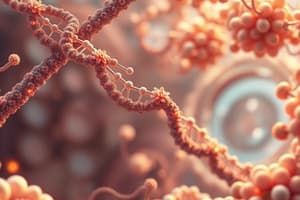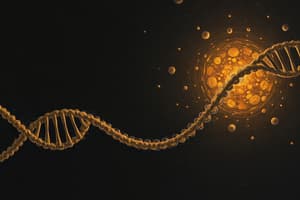Podcast
Questions and Answers
What enzyme is responsible for synthesizing mRNA during transcription?
What enzyme is responsible for synthesizing mRNA during transcription?
- DNA helicase
- RNA polymerase (correct)
- RNA exonuclease
- RNA ligase
What is a codon?
What is a codon?
- A protein complex
- A sequence of three nucleotides on mRNA (correct)
- A sequence of amino acids
- A three-nucleotide sequence on tRNA
Where does translation occur?
Where does translation occur?
- In the nucleus
- In the endoplasmic reticulum
- In the mitochondria
- In the cytoplasm, at the ribosome (correct)
What is the first step of DNA replication?
What is the first step of DNA replication?
What signals the end of translation?
What signals the end of translation?
Which enzyme is responsible for adding nucleotides during DNA replication?
Which enzyme is responsible for adding nucleotides during DNA replication?
What molecule carries amino acids to the ribosome?
What molecule carries amino acids to the ribosome?
What is the central dogma of molecular biology?
What is the central dogma of molecular biology?
During transcription, which base pairs with adenine in RNA?
During transcription, which base pairs with adenine in RNA?
What is a missense mutation?
What is a missense mutation?
What occurs during the initiation step of translation?
What occurs during the initiation step of translation?
What is the role of DNA ligase during DNA replication?
What is the role of DNA ligase during DNA replication?
What happens to mRNA after transcription?
What happens to mRNA after transcription?
Which of the following occurs during the elongation phase of translation?
Which of the following occurs during the elongation phase of translation?
What is the end result of DNA replication?
What is the end result of DNA replication?
Where does transcription occur within the cell?
Where does transcription occur within the cell?
What is the main function of tRNA in protein synthesis?
What is the main function of tRNA in protein synthesis?
Which mutation type introduces a stop codon, terminating the protein early?
Which mutation type introduces a stop codon, terminating the protein early?
What is the role of RNA Polymerase during transcription?
What is the role of RNA Polymerase during transcription?
What are the complementary base pairing rules in DNA?
What are the complementary base pairing rules in DNA?
What occurs during the S phase of the cell cycle?
What occurs during the S phase of the cell cycle?
In DNA replication, what is formed when helicase unwinds the DNA?
In DNA replication, what is formed when helicase unwinds the DNA?
Why is the lagging strand synthesized in fragments?
Why is the lagging strand synthesized in fragments?
What is the role of rRNA in protein synthesis?
What is the role of rRNA in protein synthesis?
Flashcards
DNA replication
DNA replication
The process of creating an identical copy of DNA for cell division.
DNA
DNA
A double-stranded molecule that contains the genetic instructions for an organism.
Helicase
Helicase
An enzyme that unwinds and unzips the DNA molecule during replication.
DNA polymerase
DNA polymerase
Signup and view all the flashcards
Semi-conservative replication
Semi-conservative replication
Signup and view all the flashcards
Transcription
Transcription
Signup and view all the flashcards
mRNA
mRNA
Signup and view all the flashcards
Translation
Translation
Signup and view all the flashcards
DNA Ligase
DNA Ligase
Signup and view all the flashcards
Protein Synthesis
Protein Synthesis
Signup and view all the flashcards
Codon
Codon
Signup and view all the flashcards
Anticodon
Anticodon
Signup and view all the flashcards
Missense mutation
Missense mutation
Signup and view all the flashcards
Nonsense mutation
Nonsense mutation
Signup and view all the flashcards
Silent mutation
Silent mutation
Signup and view all the flashcards
Frameshift mutation
Frameshift mutation
Signup and view all the flashcards
Study Notes
DNA Replication
- DNA replication ensures each new cell receives an exact copy of the DNA
- It occurs during the S phase of the cell cycle, entirely within the nucleus
- Steps of DNA Replication:
- Unwinding and Unzipping DNA: Helicase breaks hydrogen bonds between nitrogenous bases, creating a replication fork. The two DNA strands are now exposed for complementary base pairing.
- Complementary Base Pairing: Free nucleotides in the nucleus pair with the exposed bases on each DNA strand. Adenine (A) pairs with Thymine (T), and Cytosine (C) pairs with Guanine (G).
- Joining of the New Strand: DNA polymerase synthesizes the new DNA strand by forming covalent bonds between the sugar-phosphate backbones. DNA ligase seals gaps in the sugar-phosphate backbone.
- Result: Two identical DNA molecules, each with one original (parent) strand and one new strand (semi-conservative replication).
- Key Enzymes in Replication:
- Helicase: Unwinds and unzips DNA
- DNA Polymerase: Adds nucleotides to form the new strand
- DNA Ligase: Joins fragments of the DNA backbone
Protein Synthesis
-
Protein synthesis converts genetic information from DNA into functional proteins. It consists of transcription and translation.
-
Transcription (DNA → mRNA):
- Occurs in the nucleus and produces a single-stranded RNA molecule (mRNA) based on the DNA template
- Steps of Transcription:
- Unzipping the DNA: Helicase unwinds the DNA double helix
- RNA Complementary Base Pairing: Free RNA nucleotides pair with the exposed DNA strand. Adenine (A) pairs with Uracil (U) in RNA (instead of Thymine). Cytosine (C) pairs with Guanine (G)
- mRNA Synthesis: RNA polymerase links the RNA nucleotides, forming the mRNA strand. The mRNA strand detaches and exits the nucleus to the cytoplasm.
-
Translation (mRNA → Protein):
- Occurs in the cytoplasm on ribosomes. Translation converts mRNA into a chain of amino acids (protein)
- Steps of Translation:
- Initiation: Ribosome attaches to the start codon (AUG) on mRNA. A tRNA with the complementary anticodon (UAC) brings the amino acid methionine.
- Elongation: Ribosome reads mRNA codons. tRNA and amino acids are added to the growing polypeptide chain
- Termination: Ribosome reaches a stop codon (UAA, UAG, or UGA). The polypeptide chain is released, folding into a functional protein.
-
Key Molecules in Protein Synthesis:
- DNA: The template for genetic information.
- mRNA: Carries genetic instructions from DNA to ribosomes.
- tRNA: Transfers amino acids to ribosomes.
- rRNA: A component of ribosomes that catalyzes protein synthesis.
-
Key Concepts and Terms:
- Nitrogenous Bases
- DNA: Adenine (A), Thymine (T), Cytosine (C), Guanine (G).
- RNA: Adenine (A), Uracil (U), Cytosine (C), Guanine (G).
- Genetic Code
- Codons: Groups of three mRNA bases
- Each codon specifies one amino acid
- Mutations:
- Point Mutation: A single base change
- Silent Mutation: No effect on protein
- Missense Mutation: Changes one amino acid
- Nonsense Mutation: Introduces a stop codon, terminating the protein early
- Frameshift Mutation: Insertion or deletion of bases, altering the reading frame
Studying That Suits You
Use AI to generate personalized quizzes and flashcards to suit your learning preferences.




